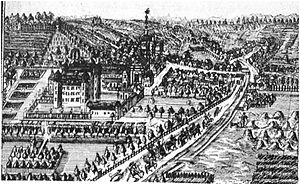Hochmilchling Castle
| Hochmilchling Castle | ||
|---|---|---|
|
Former castle backdrop |
||
| Alternative name (s): | Veste Burgmilchling, Hochmilchling Castle | |
| Creation time : | First mentioned in 1096 | |
| Castle type : | Niederungsburg | |
| Conservation status: | Burgstall | |
| Construction: | Quarry stone | |
| Place: | Wilhermsdorf | |
| Geographical location | 49 ° 28 '50.2 " N , 10 ° 42' 57" E | |
|
|
||
The castle high Milchling even Veste castle Milchling and Castle High Milchling called, is a Outbound medieval moated castle in Wilhermsdorf in the district Fürth in Bavaria .
history
In 1096, Wilhermsdorf (then still Wilhelmsdorf) was mentioned in a document as a fortress of the warring knight dynasty of the nobles of Wilhelmsdorf. In 1566 Wolff von Wilhelmsdorf sold the manors Wilhelmsdorf and Neidhardswinden to the Schutzbar brothers called Milchling, who came from Hesse . Heinrich Hermann von Burgmilchling, born in 1536 and sole owner of Wilhermsdorf, rebuilt the burned down Veste Wilhelmsdorf as a stately moated castle, called Burgmilchling. After Heinrich Hermann von Burgmilchling "the Elder" died in 1592, his son Heinrich Hermann Freiherr zu Burgmilchling "the Younger" (* 1575, † 1655) took over the rule of Wilhermsdorf, traditionally a benevolent lord of the castle and a friend of the sciences In 1597 Emperor Rudolf II was granted the privilege of minting his own thalers. In 1632 Gustav Adolf of Sweden stayed at Burgmilchling.
After the death of Freiherr von Burgmilchling, who left no heirs, Wilhermsdorf changed its aristocratic owners several times. In 1667 Count Wolfgang Julius von Hohenlohe-Neuenstein , who had already received high honors as Field Marshal General Field Marshal in the war against the Turks near Vienna in 1664, acquired the rule of Wilhermsdorf and Neidhardswinden and had the Veste Burgmilchling demolished from 1672 to 1693 and a new one Erect a residential castle from rubble stones with outbuildings and a magnificent castle garden, which is what today's street and square names "castle courtyard" and "castle garden" remind of. After the privately owned residential palace, which had come into state ownership, was auctioned off in 1878–79, neglected.
literature
- Ruth Bach-Damaskinos, Jürgen Schabel, Sabine Kothes: Palaces and castles in Middle Franconia. A complete representation of all palaces, manors, castles and ruins in the Central Franconian independent cities and districts . Verlag A. Hoffmann, Nuremberg 1993, ISBN 3-87191-186-0
Web links
- History of Wilhermsdorf at markt-wilhermsdorf.de
- From the knight family to the market community at heimatverein-wilhermsdorf.de
- Entry for Schloss Hochmilchling in the private database "Alle Burgen".




